Hans Rey Adventure Team trip with Richie Schley: “Mountain Kenya Rage 2004”
http://dockmandigital.com/solutionfilms/MT_KENYA_TRAILER_FINAL010407.mov 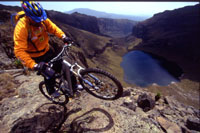
This was a serious undertaking not only because of the high altitude but also because of the constantly changing terrain which turned out to be more challenging than expected. Along with us was a small film-crew, Bob Poole and John Mans, who documented this expedition on HD (high definition) film for television and still photographer Blake Jorgenson; along with our local guide Dickson and the porters who carried our tents, food and camera-gear.I’m sitting at the edge of the Indian Ocean reflecting on my latest “Hans Rey Adventure Team” trip which just ended a few days ago. The goal was to be the first to traverse and summit Mt. Kenya (16,300 feet/ 5,000-meters) in East Africa on mountain bikes. My partner for this trip was freeriding legend and pioneer Richie Schley from Canada. Mount Kenya, Africa’s second highest mountain, is a world class trekking destination, it’s a very gradual mountain with some jagged peaks on top. Along the way we crossed several clima-zones with very diverse flora and fauna; from the open savanna to rain-forests to equatorial glaciers. They say on Mountain Kenya, every day is summer and winter – trust me – we lived it. 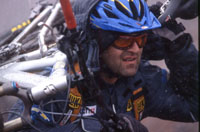 We decided to bring our freeride bikes (GT Ruckus Flowta and a Rocky Mountain Switch), knowing that we were going to pay for it on on the uphill; however we are known for our extreme biking skills and we wanted to be prepared for the rough descend. We also knew that we had to take our time on the way up to avoid altitude sickness, none of us had ever ridden above 15,000 feet. That wasn’t our only concern, we were warned of elephants, buffalos, lions, contaminated water and malaria mosquitos. I arrived in Nairobi on Feb. 25th, a couple days before Richie arrived. I had the chance to meet world reknown elephant researcher and conservationist, Ian Douglas Hamilton (www.savetheelephants.com), and learn about his projects and studies of the elephants around Mt. Kenya. Within hours of my arrival I was charged by a elephant mom with her newborn baby, only a couple hours after she had given birth in the middle of a tribal village and saw four lions resting next to the road – welcome to Africa! I also got to meet and hang out with some of the Samburu Warriors who still live in the bush in their traditional ways.
We decided to bring our freeride bikes (GT Ruckus Flowta and a Rocky Mountain Switch), knowing that we were going to pay for it on on the uphill; however we are known for our extreme biking skills and we wanted to be prepared for the rough descend. We also knew that we had to take our time on the way up to avoid altitude sickness, none of us had ever ridden above 15,000 feet. That wasn’t our only concern, we were warned of elephants, buffalos, lions, contaminated water and malaria mosquitos. I arrived in Nairobi on Feb. 25th, a couple days before Richie arrived. I had the chance to meet world reknown elephant researcher and conservationist, Ian Douglas Hamilton (www.savetheelephants.com), and learn about his projects and studies of the elephants around Mt. Kenya. Within hours of my arrival I was charged by a elephant mom with her newborn baby, only a couple hours after she had given birth in the middle of a tribal village and saw four lions resting next to the road – welcome to Africa! I also got to meet and hang out with some of the Samburu Warriors who still live in the bush in their traditional ways.  When Ian learned about our adventure he told me about “Icy Mike”, the elephant bones and skull that wasdiscovered years ago in a remote valley on Mt. Kenya at an incredible altitude at over 15,000 feet. Since Ian never had a chance to go there in person and nobody really knew where the exact location of Icy Mike was, he asked me to bring him a DNA sample in case I had a chance to find the elephant remains. I accepted the mission and met up with Richie and the rest of the crew in Chogoria, the east side of the mountain, to start our adventure. The Ascent: Mt. Kenya has several routes which lead to the circuit path near the top of the mountain. We had picked the famous Chogoria Route for the ascent and the Sirimon Route for our descent. On Day 1 we had a late start, we left the town of Chogoria on a beautiful 4 X 4 dirt road, observed by the entire community. It was quite a circus – but it felt really good after all of our preparations and traveling to finally ride our bikes. We camped near the forest gate and got an early start the next morning.
When Ian learned about our adventure he told me about “Icy Mike”, the elephant bones and skull that wasdiscovered years ago in a remote valley on Mt. Kenya at an incredible altitude at over 15,000 feet. Since Ian never had a chance to go there in person and nobody really knew where the exact location of Icy Mike was, he asked me to bring him a DNA sample in case I had a chance to find the elephant remains. I accepted the mission and met up with Richie and the rest of the crew in Chogoria, the east side of the mountain, to start our adventure. The Ascent: Mt. Kenya has several routes which lead to the circuit path near the top of the mountain. We had picked the famous Chogoria Route for the ascent and the Sirimon Route for our descent. On Day 1 we had a late start, we left the town of Chogoria on a beautiful 4 X 4 dirt road, observed by the entire community. It was quite a circus – but it felt really good after all of our preparations and traveling to finally ride our bikes. We camped near the forest gate and got an early start the next morning. 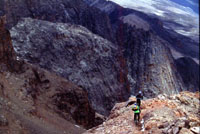 The dirt road was perfect for mountain bikes as the road winded very gradually up the hill, first through rain forrest, than bamboo forrest and after several hours we traversed the moorlands and crossed a very mystical and enchanting rosewood forest. It was very exciting since we anticipated behind each turn wild animals and new vegetation. I’m not sure whether we were lucky or unlucky not to see much wildlife, besides some monkeys, elands and very fresh elephant droppings we were annoyed by TseTse fly’s most of the morning . Day 2 was super long and hard, by the time we arrived at camp it was already dark and I was quite worried and exhausted since I could feel the altitude at 11,000 feet, I knew we had some tough days ahead of us. Day 3 was a reality check, over and gone were the times of actually riding our bikes, the trail turned into a very technical hiking trail and the air got thinner with every step. It was harder than I expected – but we both handled the terrain and altitude well. We carried and pushed our bikes all day long, while climbing a gorgeous ridge and enjoying breathtaking views. Camp 3 was at 14,000 feet (4,200 Meters), we encountered rain, snow and a thunderstorm on the way and were very happy to finally crawl into our tents for warmth and shelter. Day 4 was our acclimation day, we awoke next to a beautiful tarn/alpine lake and were surrounded by the nearby peaks of Mount Kenya and the very unique Lobilia trees which grow only on very few East African mountains. We decided to move another 1,200 feet vertical to a higher camp in order to be closer to the summit on the next day. Again we had a nice morning but got rained and snowed on in the afternoon. I felt super charged and ready for the summit. It was a miserable night – temperature were below freezing.
The dirt road was perfect for mountain bikes as the road winded very gradually up the hill, first through rain forrest, than bamboo forrest and after several hours we traversed the moorlands and crossed a very mystical and enchanting rosewood forest. It was very exciting since we anticipated behind each turn wild animals and new vegetation. I’m not sure whether we were lucky or unlucky not to see much wildlife, besides some monkeys, elands and very fresh elephant droppings we were annoyed by TseTse fly’s most of the morning . Day 2 was super long and hard, by the time we arrived at camp it was already dark and I was quite worried and exhausted since I could feel the altitude at 11,000 feet, I knew we had some tough days ahead of us. Day 3 was a reality check, over and gone were the times of actually riding our bikes, the trail turned into a very technical hiking trail and the air got thinner with every step. It was harder than I expected – but we both handled the terrain and altitude well. We carried and pushed our bikes all day long, while climbing a gorgeous ridge and enjoying breathtaking views. Camp 3 was at 14,000 feet (4,200 Meters), we encountered rain, snow and a thunderstorm on the way and were very happy to finally crawl into our tents for warmth and shelter. Day 4 was our acclimation day, we awoke next to a beautiful tarn/alpine lake and were surrounded by the nearby peaks of Mount Kenya and the very unique Lobilia trees which grow only on very few East African mountains. We decided to move another 1,200 feet vertical to a higher camp in order to be closer to the summit on the next day. Again we had a nice morning but got rained and snowed on in the afternoon. I felt super charged and ready for the summit. It was a miserable night – temperature were below freezing. 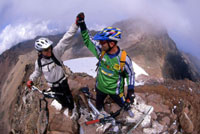 The Summit: We started early morning on March 2nd 2004, as soon as the sun had defrosted our frozen hydraulic brakes we hike n’ biked the last 1,200 vertical feet to the summit of Point Lenana, the “trekkers peak” and one of the highest points on Mt. Kenya at 16,300 feet/ 4,985 meters. We were the first to accomplish this task with bikes – our real mission, the first descent, which we had been looking forward to for the last several days of schlepping our bikes uphill, was just about to begin.
The Summit: We started early morning on March 2nd 2004, as soon as the sun had defrosted our frozen hydraulic brakes we hike n’ biked the last 1,200 vertical feet to the summit of Point Lenana, the “trekkers peak” and one of the highest points on Mt. Kenya at 16,300 feet/ 4,985 meters. We were the first to accomplish this task with bikes – our real mission, the first descent, which we had been looking forward to for the last several days of schlepping our bikes uphill, was just about to begin. 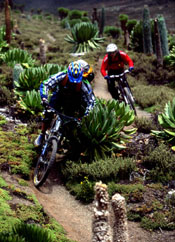 The Descent: We had summited from the North, and we were riding down to the South towards Austrian Hut along the Lewis Glacier. The trail was very exposed and technical, to say the least, we could ride about 80%. The downhills proved to be not much less exhausting than the uphills and challenged us all the way back to camp. We traversed back around the side of the peaks to the same camp we had stayed the night before. We came along the site of a recent airplane crash; with parts and pieces scattered all over the mountain side – it was quite erie.
The Descent: We had summited from the North, and we were riding down to the South towards Austrian Hut along the Lewis Glacier. The trail was very exposed and technical, to say the least, we could ride about 80%. The downhills proved to be not much less exhausting than the uphills and challenged us all the way back to camp. We traversed back around the side of the peaks to the same camp we had stayed the night before. We came along the site of a recent airplane crash; with parts and pieces scattered all over the mountain side – it was quite erie. 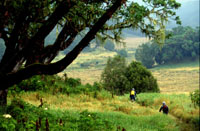 I still had to accomplish my secondary mission to find the remains of Icy Mike. Early morning on Day 6 I left camp without my bike and only with our guide Dickson to hike into a remote valley on the northeast side of the mountain to look for the elephant remains. After 5 – 6 hours of hiking and searching my guide finally admitted that he wasn’t so sure about the exact whereabouts of Icy Mike, luckily we ended up finding him after all. It was quite impressive, and made me wonder what drove that elephant to climb that high up the mountain. Hopefully my DNA sample will help shed some light on this mysterious find. Ian has been monitoring elephants for several decades, in recent years they have put GPS sensors on some elephants to study their migration routes and patterns in order to help with conservation and problems between the elephants and local farmers and poachers. It is a very important study and I was glad that I could be a part of his project and contribute in a small way with my biking expedition. Richie turned out to be a great partner for this trip, I knew he had some incredible biking skills, I wasn’t so sure about his endurance skills or trials skill which were required on the upper part of the downhill. He managed superbly and I think he really enjoyed this whole journey.
I still had to accomplish my secondary mission to find the remains of Icy Mike. Early morning on Day 6 I left camp without my bike and only with our guide Dickson to hike into a remote valley on the northeast side of the mountain to look for the elephant remains. After 5 – 6 hours of hiking and searching my guide finally admitted that he wasn’t so sure about the exact whereabouts of Icy Mike, luckily we ended up finding him after all. It was quite impressive, and made me wonder what drove that elephant to climb that high up the mountain. Hopefully my DNA sample will help shed some light on this mysterious find. Ian has been monitoring elephants for several decades, in recent years they have put GPS sensors on some elephants to study their migration routes and patterns in order to help with conservation and problems between the elephants and local farmers and poachers. It is a very important study and I was glad that I could be a part of his project and contribute in a small way with my biking expedition. Richie turned out to be a great partner for this trip, I knew he had some incredible biking skills, I wasn’t so sure about his endurance skills or trials skill which were required on the upper part of the downhill. He managed superbly and I think he really enjoyed this whole journey. 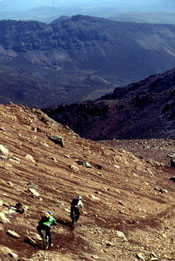 Day 7 was pure downhilling. The crew and porters had a hard time keeping up. The upper part to Shipton’s Camp was quite steep and technical with some loose spree fields until we reached the not so steep slopes of the northern Sirimon Route. We rode endless singletrail and started to cross some of the same flora zones we had crossed on the way up, but this time with a big grin on our faces. The riding was still technical and the trail didn’t open up until the last few kilometers before Judmeier Camp. We had a great party with all the porters around a campfire grilling goat and singing songs. We learned to respect our porters a lot during our days together on the mountain. Their equipment was of much lesser quality than ours, nonetheless they never complaint although they were just wearing cheap sandals and carried loads much heavier than the bikes and day-packs we had to carry. They live a hard life and earn less than $ 400.- per year as farmers, we were glad to leave them much of our warm clothes and gear at the end of the trip. Our guide had arranged some beers to be brought up the mountain from the backside, which we consumed religiously; this action could have only be topped by our first shower in 7 days, but we would have to wait another day until we got to the bottom of the mountain for the latter novelty. Day 8 started at about 10,000 feet on a fast 4 X 4 track, we speeded downhill, oblivious to the danger of startled buffalo or elephant. Luckily we only encountered some baboons, although we were really hoping to see some species of the Big Five. We crossed the equator from the Southern Hemisphere to the Northern Hemisphere right before the Sirimon Park Gate. This was an unforgettable adventure and to end it with a two and half day downhill ride couldn’t have been any better. We were spent, exhausted, jubilant and ripe – and we weren’t done yet. We were on the guest list to race in the annual “10 to 4” (50km) race the next day. It was the last thing we wanted to do, but we couldn’t pass up the opportunity nor let down the people of the Mt. Kenya Trust who organized this event to raise funds for Mt. Kenya National Park.
Day 7 was pure downhilling. The crew and porters had a hard time keeping up. The upper part to Shipton’s Camp was quite steep and technical with some loose spree fields until we reached the not so steep slopes of the northern Sirimon Route. We rode endless singletrail and started to cross some of the same flora zones we had crossed on the way up, but this time with a big grin on our faces. The riding was still technical and the trail didn’t open up until the last few kilometers before Judmeier Camp. We had a great party with all the porters around a campfire grilling goat and singing songs. We learned to respect our porters a lot during our days together on the mountain. Their equipment was of much lesser quality than ours, nonetheless they never complaint although they were just wearing cheap sandals and carried loads much heavier than the bikes and day-packs we had to carry. They live a hard life and earn less than $ 400.- per year as farmers, we were glad to leave them much of our warm clothes and gear at the end of the trip. Our guide had arranged some beers to be brought up the mountain from the backside, which we consumed religiously; this action could have only be topped by our first shower in 7 days, but we would have to wait another day until we got to the bottom of the mountain for the latter novelty. Day 8 started at about 10,000 feet on a fast 4 X 4 track, we speeded downhill, oblivious to the danger of startled buffalo or elephant. Luckily we only encountered some baboons, although we were really hoping to see some species of the Big Five. We crossed the equator from the Southern Hemisphere to the Northern Hemisphere right before the Sirimon Park Gate. This was an unforgettable adventure and to end it with a two and half day downhill ride couldn’t have been any better. We were spent, exhausted, jubilant and ripe – and we weren’t done yet. We were on the guest list to race in the annual “10 to 4” (50km) race the next day. It was the last thing we wanted to do, but we couldn’t pass up the opportunity nor let down the people of the Mt. Kenya Trust who organized this event to raise funds for Mt. Kenya National Park. 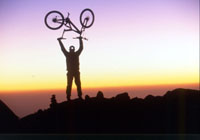 The Race: As soon we got off the mountain from our Mt. Kenya first descent, we had a few hours time to shower, eat and tune our bikes, before we got shuttled up the hill to the campsite of the upcoming event. 10 to 4 means a point to point race from the base of Mt. Kenya at 10,000 feet to the bushlands some 35 miles below at 4,000 feet. Although it sounded like a lot of downhill it was a 2-hour sprint race from start to finish and I was wishing for Frischknecht’s legs more than once. The race turned out to be the Grand Finale to our trip. There were about 140 entries and I felt like I was at a mountain biking event in California around 1987/88. I have rarely seen or felt the spirit of mountain biking in such a great manner since those days. There were young and old people, farmboys, and guys with mountaineer helmets and knee-socks, cheap bikes and ridget bikes and last but not least; Black Mambas, which are heavy, 28inch, singlespeed bikes from India without brakes. It was unbelievable one blind guy rode on the back of a tandem and a one legged guy tried to pass me on the first uphill right after the start. The organizers used a helicopter to clear the race course from elephants, giraffes and other wildlife; rangers with AK 47’s assault weapons where along the course in remote areas for protection while villagers or tribal warriors were cheering us on when riding through settlements. It was a tough event, the heat didn’t make it any easier. I ended up in 4th place, Richie came in 8th place. The course was very rough at places and I still wonder how the fastest of the Black Mamba riders came in less than 10 minutes behind me. I entertained everybody with a small trials show at the awards; everybody camped out in the bush that night before we returned to civilization. (all photos copyright by Blake Jorgenson: [email protected]) Hans Rey http://hansrey.com/wp-content/uploads/oldhans/ MORE AFRICA ADVENTURE TRIP PICTURES >>
The Race: As soon we got off the mountain from our Mt. Kenya first descent, we had a few hours time to shower, eat and tune our bikes, before we got shuttled up the hill to the campsite of the upcoming event. 10 to 4 means a point to point race from the base of Mt. Kenya at 10,000 feet to the bushlands some 35 miles below at 4,000 feet. Although it sounded like a lot of downhill it was a 2-hour sprint race from start to finish and I was wishing for Frischknecht’s legs more than once. The race turned out to be the Grand Finale to our trip. There were about 140 entries and I felt like I was at a mountain biking event in California around 1987/88. I have rarely seen or felt the spirit of mountain biking in such a great manner since those days. There were young and old people, farmboys, and guys with mountaineer helmets and knee-socks, cheap bikes and ridget bikes and last but not least; Black Mambas, which are heavy, 28inch, singlespeed bikes from India without brakes. It was unbelievable one blind guy rode on the back of a tandem and a one legged guy tried to pass me on the first uphill right after the start. The organizers used a helicopter to clear the race course from elephants, giraffes and other wildlife; rangers with AK 47’s assault weapons where along the course in remote areas for protection while villagers or tribal warriors were cheering us on when riding through settlements. It was a tough event, the heat didn’t make it any easier. I ended up in 4th place, Richie came in 8th place. The course was very rough at places and I still wonder how the fastest of the Black Mamba riders came in less than 10 minutes behind me. I entertained everybody with a small trials show at the awards; everybody camped out in the bush that night before we returned to civilization. (all photos copyright by Blake Jorgenson: [email protected]) Hans Rey http://hansrey.com/wp-content/uploads/oldhans/ MORE AFRICA ADVENTURE TRIP PICTURES >> 















